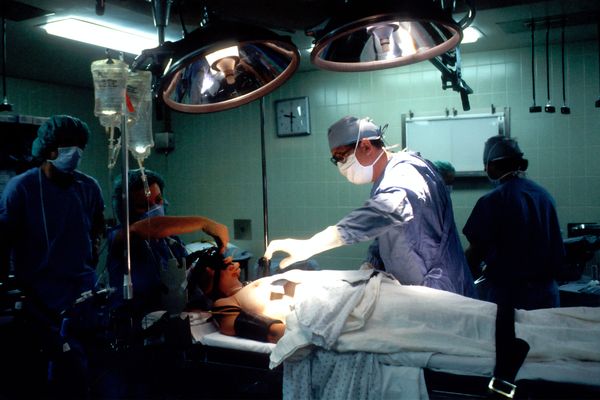Sickle Cell Anemia
Sickle cell anemia is a genetic disorder of hemoglobin; which originated in Africa. The causative gene modifying the chemical structure is the hemoglobin beta chain. It does this by substituting the amino acid valine for glutamic acid.
Sickle cell anemia was transmitted to the United States, Arabia, Europe, and South and Central America as part of the slave trade. This explains the 15 percent of people in the world with various forms of sickle cell disease who are not phenotypically African in appearance (Powars, 2013). Sickle cell anemia was the first diagnosed disease that was genetically characterized and linked to the hemoglobin protein. Hemoglobin ‘S’ was discovered by American chemist, Linus Pauling in 1949. This was the first presentation that the production of an abnormal protein could be the cause of a genetic disorder. In 1956, biologist Vernon Ingram identified the abnormality in the amino acid sequence of the βeta-globin chain (Mohanty, 2014).
The hemoglobin molecule has two parts: two alpha chains and two beta chains. Patients with sickle cell anemia have a mutation in a gene, on chromosome 11, which codes for the beta subunit of the hemoglobin protein. As a result, hemoglobin molecules don't form properly. This causes the red blood cells to be rigid and have a concave/sickle shape. These irregularly shaped cells get stuck in the affected person’s blood vessels, and are unable to transport oxygen effectively; causing pain to the afflicted and damage to major organs(GSLC, 2014). The organs affected by sickle cell disease include: the liver, heart, kidneys, and gallbladder.
Where is theHBB (Hemoglobin Beta)gene located?
Cytogenetic Location: 11p15.5
Molecular Location on chromosome 11: base pairs 5,225,465 to 5,227,070
http://ghr.nlm.nih.gov/gene/HBB/show/print
Sickle cell anemia is the result of a point mutation on the sixth codon of the hemoglobin beta gene (HBB) (Kalleas, 2012). A point mutation is a change in just one nucleotide base in the genetic material for the hemoglobin gene. Although only point mutations cause sickle cell anemia, more than 200 point mutations and insertions/deletions have been reported (Kalleas, 2012). Three types of point mutations include: a single nucleotide base change, an insertion, or deletion. Regardless, only one nucleotide will be changed in a point mutation at a time. This mutation results in the production of an abnormal version of beta-globin called hemoglobin S or HbS and leads to an overall change in the hemoglobin structure and red blood cell functioning. The point mutation causes the sickle-shaped blood cells to clog in the capillaries, cutting off a person’s circulation. Having two copies of the mutated gene causes sickle cell anemia, but having one copy does not. This single copy of the gene can protect someone against malaria; a mosquito-borne disease of humans and other animals. Here is an example of how mutations can be beneficial for organisms (TMI, 2013).
http://www.creationbc.org/index.php?option=com...
http://learn.genetics.utah.edu/content/disorders/s...
Sickle cell anemia is the most common, and the most severe form of sickle cell disease. It results from the inheritance of the sickle cell gene from both parents. It is a recessive trait, so both parents would have to be carriers for the offspring to attain the disease. Its trademark clinical manifestations are anemia and severe episodes of pain (Powars, 2013). There are similar but less frequent explanations that are seen with other forms of sickle cell disease. In sickle cell anemia, anemia is caused by the rapid destruction of red blood cells as they circulate, because of a shortened peripheral survival time of less than 30 days. Normally, the lifespan of a red blood cell is 120 days (Powars, 2013). This is different from another form of anemia; which is most likely caused from a lack of absorbing the daily amount of iron needed.
http://learn.genetics.utah.edu/content/disorders/singlegene/sicklecell/
To conclude, Sickle cell anemia is a genetic disorder of hemoglobin; which originated in Africa. The causative gene modifying the chemical structure is the hemoglobin beta gene. It does this by substituting the amino acid valine for glutamic acid. Sickle cell anemia was the first diagnosed disease that was genetically characterized and linked to the hemoglobin protein. Hemoglobin ‘S’ was discovered by American chemist, Linus Pauling in 1949; and in 1956, biologist Vernon Ingram identified the abnormality in the amino acid sequence of the βeta-globin chain (Mohanty, 2014). Patients with sickle cell anemia have a mutation which codes for the beta subunit of the hemoglobin protein. As a result, hemoglobin molecules don't form properly which causes the red blood cells to have sickle shape. Sickle cell anemia is the result of a point mutation on the sixth codon of the hemoglobin beta gene (HBB) (Kalleas, 2012). Three types of point mutations include: a single nucleotide base change, an insertion, or deletion. This mutation leads to an overall change in the hemoglobin structure and red blood cell functioning. Having two copies of the mutated gene causes sickle cell anemia, but having one copy does not (TMI, 2013).
Bibliography
Genetic Science Learning Center, “Sickle Cell Disease, “Learn. Genetics,
22 June 2014, http://learn.genetics.utah.edu/content/disorders/singlegene/sicklecell/ (17 September 2015)
Kalleas, Christoforos, Kostas Anagnostopoulos, Kilo Sinopoulou, Evangelia Delaki, Dimitrios
Margaritis, Georgios Bourikas, Constantinos Tsatalas, Alexandros Kortsaris, and IoannisTentes. 2012. “Phenotype and Genotype Frequency of B-Thalassemia and Sickle Cell
Disease Carriers in Halkidiki, Northern Greece. “Hemoglobin 36, no. 1:64-72. EBSCO MegaFILE, EBSCOhost (accessed September 18, 2015).Mohanty, Dipika. 2014. “A century after discovery of sickle cell disease: keeping hope alive!”
Understanding Genetics, 2013, http://genetics.thetech.org/about-genetics/mutations-and-disease (17 September 2015)





















